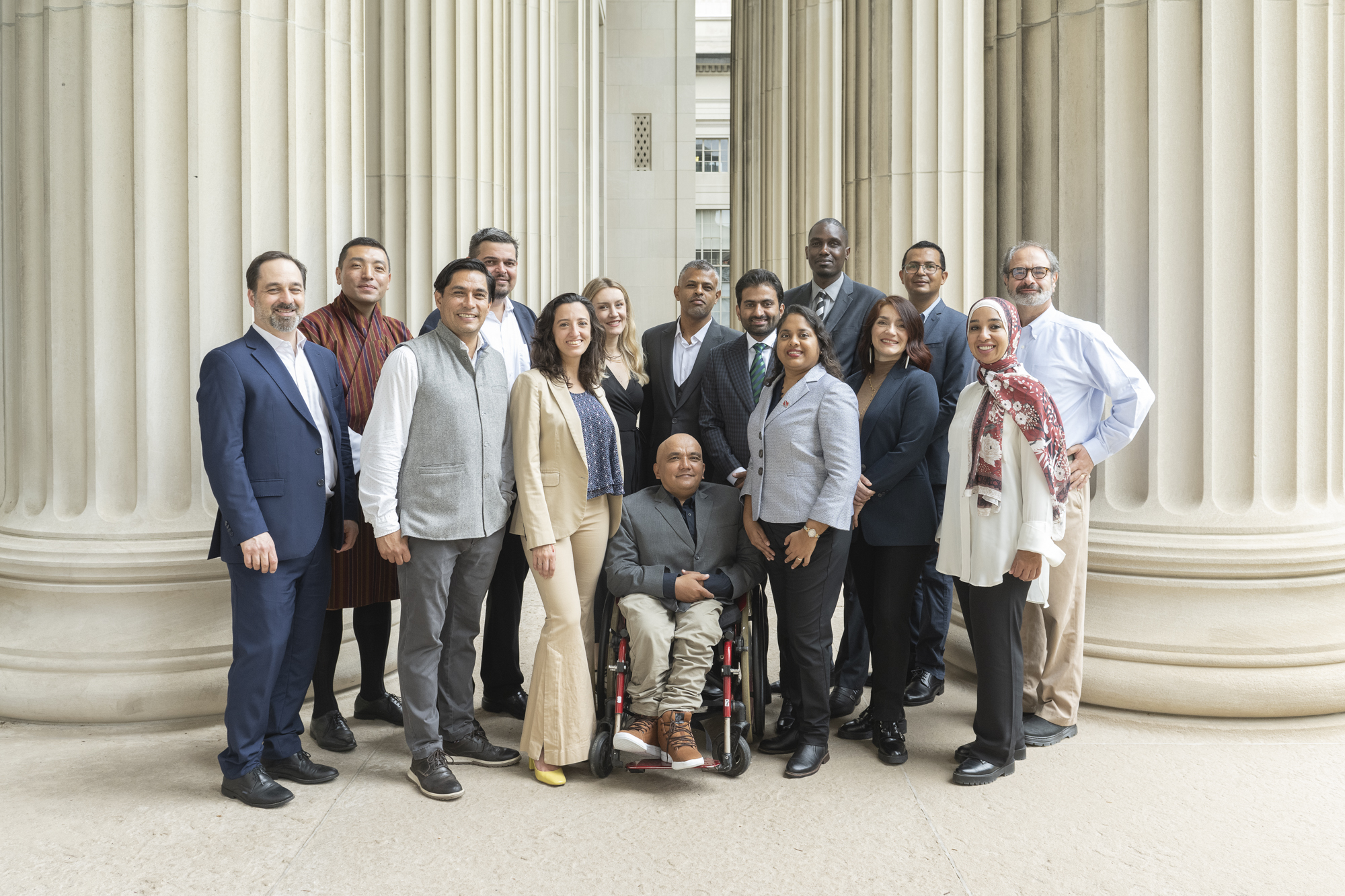Sixteen international mid-career urban planners and public administrators recently bid farewell to the MIT campus, having completed a 10-month exploration of North American education and culture designed to expand their professional networks and infuse their work with new insights as they return to influential positions in government agencies, private firms, and other organizations throughout the developing world.
Hailing from Argentina, Bhutan, China, Egypt, Honduras, India, Kosovo, Mexico, Nepal, Pakistan, Trinidad & Tobago, Yemen, and Zimbabwe, they comprise this year’s group of MIT Special Program for Urban and Regional Studies (SPURS) Fellows. Founded in the Department of Urban Studies and Planning in 1967, SPURS has drawn from 135 countries to host more than 750 mid-career individuals who are or will be shaping policy in their home countries. Along with admitting several fellows directly into SPURS, MIT has competed successfully to be among 13 U.S. universities that also host a larger group of fellows annually selected and funded by the U.S. Department of State’s Hubert H. Humphrey Fellowship Program.
Recipients of the Humphrey Fellowship have their travel to the United States, living expenses, and other costs fully financed by the U.S. State Department. Perhaps equally valuable — and some say unique among international fellowships — is a focus that frees all fellows to explore beyond classroom teachings to learn, and advance their professional development without the pressure of earning a degree.
“This is the best reward of my life, this year at MIT and Cambridge in general,” says Carina Arvizu-Machado of Mexico, former cities director for Mexico and Colombia at the World Resources Institute and Mexico’s former national deputy secretary of urban development and housing, who is sponsored by the Humphrey Fellowship. “I think this year of stepping back and stepping out of the active life that we have as professionals and being able to reflect, to learn, to exchange ideas — it’s very useful.”
Arvizu-Machado’s sentiments are echoed by many past and present fellows, says Bish Sanyal, MIT’s Ford International Professor of Urban Development and Planning and director of SPURS since 2004.
“The fellows mention that this one year has given them a real opportunity to reflect on what they have done in the past and what they are going to do in the future,” he says, adding that the value of developing professional networks with peers in other developing countries can’t be overstated. “Some have never met colleagues from another country before. The program provides the ideal setting to reflect on professional challenges, collectively, without political concerns which stifle frank deliberation in their home countries.”
While some SPURS Fellows might not be well-traveled before coming to MIT, they are nonetheless a uniformly “very highly motivated and politically powerful group,” Sanyal says — movers and shakers in their home countries in fields such as urban planning, economics, governance, and business development. Some notable alumni include the current managing director of the International Monetary Fund, a former CEO of the World Bank, former ambassadors to the United States from Colombia and Haiti, the corporate vice president of strategic programming of Banco de Desarrollo de América Latina or CAF (Latin America’s largest development bank), and a Nepalese Supreme Court justice.
“When the Ebola outbreak happened in Africa, the person who headed the Ebola response team in Liberia was a SPURS Fellow,” Sanyal says.
The benefits of having a such an accomplished and cosmopolitan group of people on campus flow both ways, says Allan Goodman, CEO of the Institute of International Education (IIE), which administers the Humphrey Fellowship for the state department.
“It really enriches MIT … and all the places that are participating,” Goodman says. “The undergraduate and graduate students interact with the fellows, and they wouldn’t ordinarily have that chance. You have a ready-made group of international consultants who are focused on the theme of your department.”
Each university participating in the Humphrey Fellowship program is assigned fellows based on a specific area of expertise. With SPURS housed within the Department of Urban Studies and Planning at MIT, the programmatic focus is on urban and regional planning. Sanyal remarks that this focus is deliberate and consistent regardless of whether fellows are sponsored by the U.S. Department of State or other agencies from the fellows’ home countries. One difference, however, is that Humphrey Fellows are required to be professionally affiliated for at least six weeks with U.S.-based organizations in their areas of work or interest — an engagement described as a cross between an internship and pro-bono consultancy that provides fellows the opportunity to develop professional relationships with U.S. practitioners.
Peter Moran, director of the Humphrey program at IIE, says the biggest value to fellows at MIT and other participating universities is the ability to step out of their past professional lives and reflect from a fresh perspective on their professional aspirations to serve their nations in an interconnected world. In the process, they also benefit from the relationships with other fellows and professional partnerships that last years after they return home.
“To say it broadens your perspective really undersells it,” he says. “The diversity of the fellows is remarkable. It’s a lot of the world … and we are putting them all around the table together.”
By continuing to put fellows from diverse corners of the world together for over 50 years, SPURS has sparked lasting partnerships between fellows, as well as among SPURS alumni, MIT faculty and students, and other professionals they encounter during their time in Cambridge.
Two factors are key to maintaining the high quality of the program, Sanyal says.
First, additional funding could strengthen the program, and, to that end, he envisions sponsoring financially sustainable relationships with over a dozen local, national, and international agencies as long-term partners.
The second challenge is to revise the program’s objective in a rapidly changing world. This is harder to surmount. When SPURS was established in 1967, Sanyal says, there was widely held public perception that the United States ought to look outward to help democratic nations of the world.
“I think the challenge now is that many countries, including the U.S., are looking inward,” Sanyal says, adding that this inward turn increases the importance that SPURS develops a diverse portfolio of funding sources.
As Arvizu-Machado prepared to return to Mexico this spring, she recounted myriad positive experiences enabled by her fellowship — from lectures she was invited to give and graduate courses she attended to practicing yoga with her undergraduate dorm mates.
“Most important, I think, is the people I’ve met,” she says. “This includes, foremost, the other fellows. They are just amazing people. They have become part of my family. But also, some of the faculty and the extended network which this fellowship allows you to have access to. I’m very grateful to be part of this program.”
One of Arvizu-Machado’s co-fellows, Tenzin Jamtsho, agrees that the opportunity for personal connections with other fellows as well as with faculty highly respected in their fields is the aspect of SPURS that will continue to resonate when he returns to his native Bhutan. Jamtsho, director of administration and finance at Bhutan’s Druk Gyalpo’s Institute (formerly the Royal Academy), who is sponsored by the Humphrey Fellowship, says he pursued the fellowship after colleagues at home told him it would be “life changing.” His actual experience at MIT affirmed this expectation.
Jamtsho says the MIT campus offers fellows a “free-flowing environment” for learning, with opportunities to take whatever classes they’re interested in. During his fellowship, Jamtsho says he came to appreciate different ways to approach challenges — viewing problems through a “systems lens,” which he calls “a valuable skill that I am taking back home.”
Also returning to Bhutan with Jamtsho are some less-tangible aspects of his time at MIT.
“I’ve been fortunate to interact with people who are very intelligent and passionate,” he says. “What I’m going to take home is the kindness and humility of these people.”












